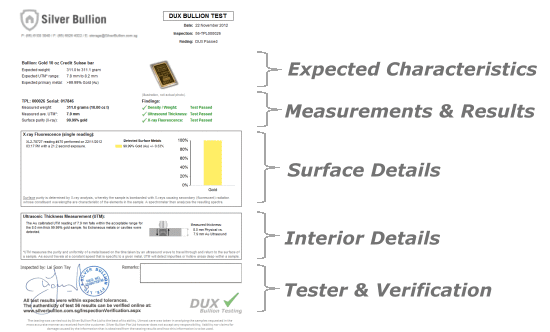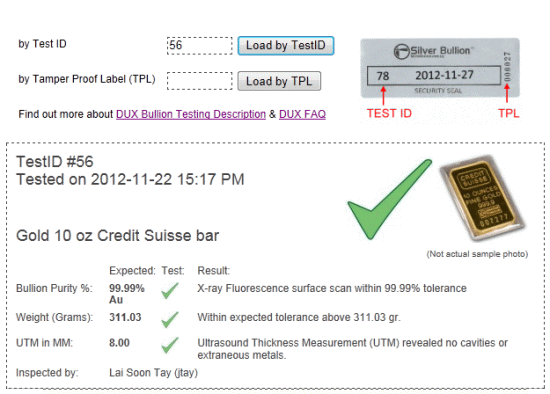Product Details
Testing - ID 281
-
0 gram (0 oz)
oz sold-
Any Quantity:Any50.00 SGD
Out-of-stock
-
DUX Bullion Testing
Fast, Precise and Comprehensive
DUX is an acronym that stands for Density Ultrasound and X-ray Fluorescence testing. Each test measures and compares a different physical characteristic (mass and volume, ultrasound celerity, and surface metal composition) in such a way that counterfeit bullion might pass an individual test but not the DUX trio of tests.
| Test 1 – “D” for Density / Weight | |
|
The first test we conduct on the coins and bars is Density / Mass. The analytical balances that we use are highly sensitive and require frequent calibration by approved vendors. The reason why we conduct this test first is because most fake bullion out in the market deviate from the genuine ones by mass. Through precision weighing, we can quickly and reliably screen out 95% of the fakes that are out there in the market. Investment Grade bullion should be within a small range above its stated mass. This is because during the production process, the mint must compensate for trace amounts of impurities present by giving small amounts (at least a few milligrams) of extra metal. This will ensure that the minimum given metal is always provided for. It is also possible for genuine bullion to be slightly below its stated mass due to excessive polishing or scratching which can result in very small mass loss. This is very rare however. |
| Test 2 – “U” for Ultrasonic Thickness Measurement (UTM) | |
|
Despite precision mass measurement, test results can be misled by high-quality fakes made of advanced composite bars and alloys. These high-quality fakes can have masses that measure exactly the same as genuine bullion items. However, metals with similar densities can exhibit very different ultrasonic properties, therefore making ultrasonics an excellent complement to the density test. By complementing precision weighing and Ultrasonic Thickness Measurement (UTM), it is extremely difficult for a fake bar to pass both tests. Ultrasonics tests measure a whole range of properties. The property that we focus on is called “Celerity”. Celerity is the velocity at which sound waves travel through the metal. The Celerity of every element is characteristic to that element and can vary greatly:
For example, a typical 10 oz Credit Suisse gold bar that is 8mm in thickness would give a reading of approximately 8mm in an ultrasonics measurement. If it was a gold-plated tungsten bar, the ultrasonics measurement would read only 5.0 mm. This is because sound waves travel at a much faster velocity (see above) through tungsten therefore resulting in a much lower reading. UTM can also be used to detect hollow areas inside the bar. |
|
 |
| Putting it all together - The DUX Bullion Testing System | |
|
A reliable test standard requires tightly controlled, standardized procedures as well as traceability and a uniformity of testing parameters that do not vary subjectively based on the test operator. The DUX bullion testing system is a set of procedures enforced by custom software that interfaces directly with the DUX testing equipment to offer maximum automation and traceability while minimizing the likelihood of human errors. The basis of DUX are the X-ray spectrometers which, being powerful computers in their own right, store test results in tamper proof onboard memories providing excellent testing traceability. During an inspection the DUX system uploads X-ray spectrometry data directly into the central DUX database along with the spectrometer ID and reading IDs. The operator then specifies the type of bullion that is being tested (e.g. a 10 oz Gold Credit Suisse bar) from our DUX product database which automatically loads the Weight, UTM, Metal and Purity parameters as well as the associated deviation tolerances and physical bullion particularities (e.g. raised bar borders which would affect the UTM vs. Physical Thickness metrics) for the tested bullion. Once the Weight and UTM test results are entered the system then determines whether the results are within our acceptable tolerances and generates the DUX bullion Test Results. This standardization not only creates consistency across inspections but also enforces access control and process traceability by keeping track of “who did what when”. Furthermore DUX test results will be retrievable online so that printed DUX test results can be verified directly with the online DUX database which keeps track of all test parameters as well as checksum and control numbers to detect potential errors or attempts to modify data. To identify and mark the tested bullion we offer our test client the option to use out uniquely ID Tamper Proof Labels (TPLs) to link the tested bullion item with their respective online test results. You can make an appointment via e-mail at [email protected] or call us to schedule for a DUX bullion test or simply visit as a walk in customer with the bullion to be tested. Standard price is 50 SGD for Silver Bullion or Certis Cisco customers (60 SGD for non-customers) and normally takes 10 to 15 minutes to complete.You will receive a DUX Test Result similar to the sample below... |
|
 ... and will also be able to verifiy test results online based on the Test ID or Tamper Proof Label (TPL) number that marks the tested sample:
|

